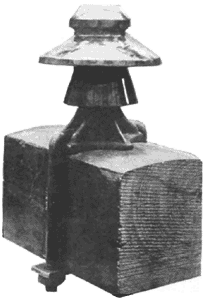[Trade Journal]
Publication: Electrical Age
New York, NY, United States
vol. 37, no. 2, p. 148-149, col. 3, 1
A New Insulator Pin
IN the description of the transmission line and third-rail system of the Long Island Railroad in the July number, attention was called to the new type of iron insulator pin employed. This pin, which is a radical departure from previous practice in pin design, is the invention of W. N. Smith, of Westinghouse,
Church, Kerr & Co., of New York. Mr. Smith has applied for a patent on the device. The design has been further improved, and arrangements are now being made for manufacturing and placing it on the market, under the name of "The Smith-Grip Insulator Pin."
 |
| Insulator Pin Designed by W. N. Smith for the Transmission Lines of the Long Island Railroad. |
It combines several important advantages, as follows:—It does away with the necessity of boring holes in the cross-arms, thereby conserving the whole strength of the arm and lengthening its life; the metal composing it is distributed in the most effective manner possible, as its cross-section is greatest next to the arm, where the greatest resistance to bending is required; and finally, the shrinkage of the arm can more effectively be taken care of by the U-bolt and strap than by any of the other forms of pin fastenings in common use. as there is no tendency to distort the bolt, and, consequently, there is no possibility of the pin standing crooked upon the arm after the shrinkage has been taken up. Furthermore, it is practicably indestructible, and instead of being one of the weakest factors in line construction, this pin is expected to be the strongest.
More than 8000 of the pins, as originally designed and shown in the accompanying illustration, were used in the transmission line construction of the Long Island Railroad, carrying 250.000 c. m. cables in spans averaging 150 feet in length, and no failures have yet been reported after over a year of service. A dozen or more standard sizes of the improved design are being worked up to fit several sizes of cross-arms and pole tops, and to carry insulators of varying sizes up to the highest voltages in practical use. The pins will be made of either cast or malleable iron to suit the purchaser's conditions, and will, it is believed, fill a long-felt want for a pin which combines, at a reasonable cost, the maximum of strength and durability both in itself and in the cross-arm to which it is fastened.
While it is designed particularly for use with wooden cross-arms, it can readily be adapted to steel crossarms, and to such special fixtures as are often necessary in heavy transmission line construction. On account of its superior mechanical design, it will also without doubt find a place in heavy catenary trolley construction, which is now being actively developed for the electrification of railways by the single-phase system.
After the arrangements for placing the Smith-grip pin upon the market have been perfected, a more detailed announcement will be made, that will he of interest to engineers and others interested in following the march of improvement in the mechanical construction of power transmission lines.
